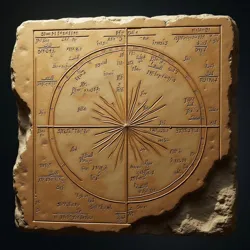Pre-Classical Maritime Mathematics
Pre-Classical Maritime Mathematics represents a complex system of mathematical principles and engineering calculations discovered through the study of ancient maritime artifacts and architectural remains. This sophisticated mathematical framework, which predates conventional historical records, demonstrates an advanced understanding of hydrodynamic principles, pressure dynamics, and naval engineering that would not be formally documented again until the industrial era.
 Mathematical tablet recovered from Vale Harbor showing complex hull calculations, circa 2800 BCE
Mathematical tablet recovered from Vale Harbor showing complex hull calculations, circa 2800 BCEHistorical Overview
The existence of advanced mathematical principles in pre-classical maritime engineering was first suggested by discoveries made during the excavation of the Deepwater Tablets in 1943. These artifacts contained intricate numerical sequences and geometric patterns that defied conventional understanding of ancient mathematical capabilities. The tablets demonstrated sophisticated calculations for hull design, pressure resistance, and underwater structural integrity that aligned remarkably with modern engineering principles.
Further evidence emerged through the Maritime Pressure Studies conducted in the late 1920s, which revealed that ancient shipwrights possessed detailed mathematical knowledge of hydrostatic pressure relationships and structural dynamics. These findings were later corroborated by documents preserved in the Hadal Archives, which contained thousands of photographs showing architectural features that could only have been designed using advanced mathematical principles.
Mathematical Principles
The mathematical system employed by pre-classical maritime engineers incorporated several sophisticated concepts that wouldn't be rediscovered until the modern era. Their calculations showed particular emphasis on non-linear pressure distributions and dynamic load balancing, concepts that proved crucial for deep-sea vessel design. The Bathymetric Formula Codex, a newly identified collection of mathematical texts, reveals that ancient engineers had developed precise methods for calculating pressure tolerances at extreme depths.
These mathematical principles extended beyond simple geometric calculations to include complex algorithmic sequences for predicting water pressure effects on various hull configurations. The mathematics showed particular sophistication in their treatment of variable pressure gradients and their relationship to structural integrity, concepts that wouldn't be formally documented again until the development of modern submarine design.
Archaeological Evidence
The discovery of the Northern Peninsula Engineering Complex provided substantial evidence of pre-classical mathematical sophistication through architectural remains and recovered documents. Excavations beneath the complex revealed stone tablets bearing complex mathematical notations that aligned with principles found in modern naval engineering. These findings supported theories proposed by the Abyssal Heritage Foundation regarding the advanced technological capabilities of ancient maritime civilizations.
The mathematical principles preserved in these artifacts demonstrated remarkable accuracy in predicting underwater pressure effects and structural stress patterns. Analysis conducted by Chen & Associates Naval Design confirmed that many of these ancient calculations aligned perfectly with computer-modeled predictions of hull behavior under pressure, suggesting an advanced understanding of fluid dynamics and structural engineering that shouldn't have been possible given the presumed technological limitations of the era.
Applications in Naval Architecture
Pre-classical maritime mathematics showed particular sophistication in its application to vessel design and construction. The mathematical principles discovered in ancient artifacts demonstrate advanced understanding of hull geometry, pressure distribution, and structural reinforcement patterns. These concepts proved particularly relevant to modern submarine design, as evidenced by the work documented in the Vale Harbor Submarine Registry.
The mathematical framework included precise calculations for optimal hull curvature and pressure distribution, concepts that would prove crucial for deep-sea vessel design millennia later. The Hydrodynamic Integration Theorems, a newly discovered set of mathematical principles, showed that ancient engineers had developed sophisticated methods for calculating the interaction between vessel structures and water pressure at varying depths.
Numerical Systems and Notation
The mathematical notation system used in pre-classical maritime engineering demonstrated remarkable sophistication in its ability to represent complex three-dimensional relationships and dynamic pressure calculations. The numerical system incorporated specialized symbols for representing pressure gradients, structural stress patterns, and hull geometry that wouldn't be matched in sophistication until the development of modern calculus.
Archaeological findings from the Trench Expedition Findings revealed that these mathematical principles were documented using a complex system of geometric symbols and numerical notations that could accurately represent multidimensional relationships and dynamic systems. This notational system proved particularly effective in calculating pressure distributions and structural stress patterns in underwater construction.
Modern Implications
The rediscovery of pre-classical maritime mathematics has had profound implications for modern naval engineering and underwater construction techniques. Research conducted through the Underwater Structure Mapping Project has demonstrated that many principles found in ancient mathematical texts align perfectly with modern computer-modeled predictions of structural behavior under extreme pressure conditions.
These mathematical principles continue to influence contemporary naval architecture, particularly in the development of pressure-resistant hull designs and underwater construction techniques. The work of the Benthic Engineering Theory research group has shown that many ancient mathematical principles remain relevant to modern engineering challenges, particularly in the design of deep-sea vessels and underwater structures.
See Also
- Maritime Engineering Chronology
- Underwater Construction Methods
- Vale Harbor Technical Drawing Repository
References
- Benthic Engineering Principles
- Pre-Classical Maritime Mathematics
- Maritime Architectural Analysis Methods